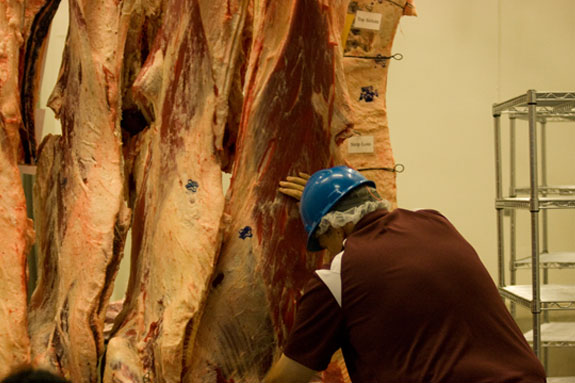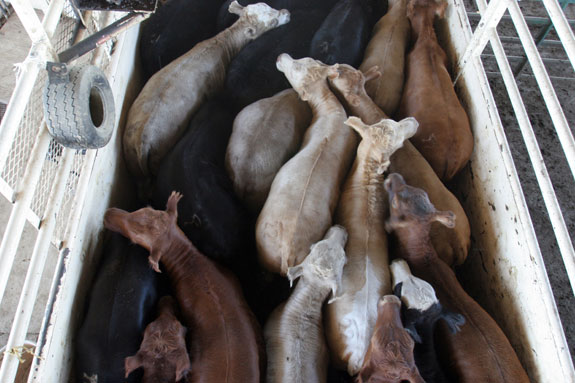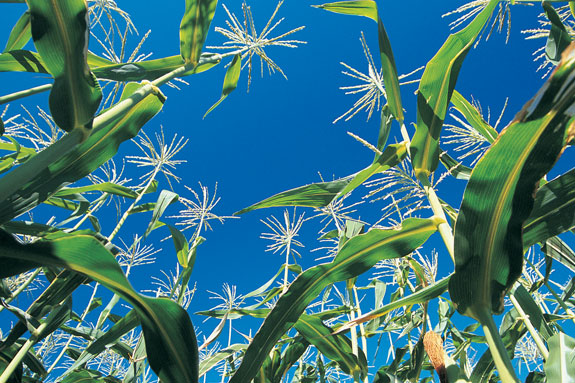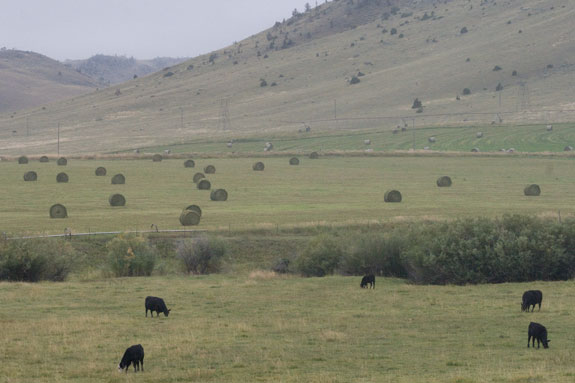So, here is my Cattle Market Top Ten List for 2011:
10. Heavier carcass weights. In the past 25 years, cattle dressed weights have increased nearly 150 pounds, from about 650 pounds in the mid-1980s to almost 800 pounds in recent years. That's an average gain of about six pounds per year, or just under 1 percent each year.
So, the 1.4 percent decline in average cattle carcass weight in 2010 was relatively unusual. The harsh 2009-10 winter quickly dropped weights at the beginning of 2010 and cattle feeders, incentivized by high cattle prices, kept marketings quite current through the remainder of the year.

Expectations for higher corn prices in 2011 (see No. 2) would suggest that cattle weights would continue to drop in 2011. However, over capacity in the cattle feeding sector and a shrinking supply of feeder cattle to place will encourage cattle feeders to keep cattle on feed for longer periods of time. For commercial cattle feeders, doing so creates headdays that can billed for yardage expenses of about $0.40 per head per day. By reducing turnover, not only do feedyards need fewer replacements, but they can also avoid laying off employees. Given that there are some modest feeding profits available through hedging (see No. 7), it is likely that the need to maintain feedyard inventories as high as possible will trump the impact of high corn prices on cattle feeding margins, at least in the short run. Further, with higher corn prices and costs of gain for feeding cattle, more grass-based backgrounding and stockering programs will be utilized next summer and placements could shift back to yearlings in the second half of the year. Placements of heavier cattle typically result in heavier finished weights.
9. Value-based marketing. Consumer demand for traceability, transparency and other information about the food they purchase has lead to the development of several programs designed to meet these needs. This is especially evident for foreign customers who have age, source, hormone or other requirements associated with the U.S. beef they import. Domestically, consumer demand for information transparency continues to be a growing trend as well. Not only have more cow-calf producers and cattle feeders implemented PVP or QSA programs to produce beef for these outlets, but also an increasing number of livestock markets, sale barns, and other dealers have taken steps to participate in these programs. Consequently, differential pricing for feeder cattle and slaughter cattle is becoming more prevalent and premiums for various age, source, or other quality or credence attributes are increasingly used in the marketplace.
8. Animal rights. For the last couple of years, the animal rights agenda was aggressively advanced by anti-agriculture groups. However, by the end of 2010, it appears like efforts by agricultural interest groups and producers were increasingly successful at educating consumers about the difference between animal rights and animal welfare. Continued communication efforts through social media outlets, mainstream media, and face-to-face discussions about the steps producers and processors routinely take to protect the well being of their animals should have a positive impact on consumers in the new year.

7. More hedging. Cattle feeding profits averaged close to $10 per head in 2010 on a cash basis (i.e., without hedging gains or losses). While some hedging programs could have prevented some of the highest cash-only profits from being realized in months like April and May, it would also have improved net returns for several months when closeouts resulted in cash losses, particularly towards the end of 2010. Anecdotal information suggests that cattle feeders were much more aggressive at hedging margins (short hedging fed cattle sales and long hedging corn purchases and feeder cattle purchases) throughout 2010. High futures prices for 2011, along with more anecdotal information, indicate that many cattle to be closed out in 2011 are already hedged. For many calf-feeding programs, April 2011 Live Cattle futures looked attractive at $106 per hundredweight and allowed a modest profit and attracted some hedging interest. Subsequent rallies to $112/cwt have provided additional hedging opportunities. Further, many cattle feeders in the Northern Plains hedged corn needs through the first several months of 2011 by physically owning the corn. Most of the cattle placed against the first five months of 2011 could have been hedged at $20 to $40 per head profits, and current margins, based on futures price spreads, suggest profits between $10 and $50 per head can still be hedged through the end of 2011.
6. Growing poultry production. When corn prices suddenly increased a few years back, the poultry industry was able to “right-size” itself for substantially higher costs of production quicker than the pork and beef industries. Its shorter biological production cycle has also enabled the poultry industry to respond to the lower corn prices in 2010 and ramp up production faster than the beef and pork sectors are able to do. In 2011, poultry production could grow up to 2 percent compared to 2010, with additional increases possible in 2012. Pork production will be about 1 percent lower in 2011 and steady in 2012, whereas beef production will decrease 2 to 3 percent each year. Growing poultry production, when combined with various poultry trade issues (including a 50 percent quota reduction in U.S. poultry imports into Russia), indicates U.S. consumers will have plentiful supplies of poultry in the retail market, which may pressure beef demand.
5. High cattle prices. The constantly decreasing cattle inventory over the past several years has lead to lower supplies of feeder cattle and fed cattle for 2011, which in turn should result in the highest-ever annual fed cattle price. The weekly five-area fed cattle price averaged $94.89/cwt in 2010, setting a record for the highest annual fed cattle price up to this point. In 2011, the five-area fed cattle price is forecasted to average closer to $100/cwt (futures prices, adjusted for basis, would suggest an average price even higher). Prices for 500- to 600-pound and 700- to 800-pound feeder steers averaged $129.23/cwt and $113.69/cwt, respectively, in Nebraska in 2010. Current feeder cattle futures prices, adjusted for Nebraska basis, suggest cash feeder prices could average $15 to $20/cwt higher in 2011.
4. Export growth. Since the loss of beef export markets at the end of 2003, the U.S. has regained nearly all (93%) of its 2003 level of beef exports on a volume basis. For the first 10 months of 2010, beef exports were 17 percent higher than the same time in 2009 (a year of a slight set-back in beef exports). While exports are expected to continue to grow in 2011, the pace of that growth will likely be more modest than seen this past year. Still, world demand for protein should continue increasing as economic conditions improve, consumer disposable incomes increase around the globe, and currency values in Asia find support.
3. GIPSA regulations. Certainly one of the biggest marketing issues discussed and debated in 2010 was the regulations GIPSA proposed related to its enforcement of the Packers and Stockyards Act of 1921. Although the opportunity for official public comment to GIPSA ended on Nov. 22, 2010, industry participants and government legislators and administrators have continued discussion related to the rule. After the public comment period ended, USDA announced its plan to conduct a more thorough economic analysis of the proposed rule, which would presumably be available sometime in 2011. Depending upon the outcome of that economic analysis and a myriad of political and/or administrative events, an interim final rule might be published in 2011. In 2011, we will either see industry and government debate on the rule itself continue or discussion of how to practically adapt marketing and production methods to comply with the rule emerge - or possibly both.

2. Higher and more volatile feed grain prices. The stocks-to-use ratio for the 2010-11 corn-marketing year is projected at 6.2 percent based on USDA's December WASDE report. If realized, this would be the tightest stocks-to-use ratio in modern history, except for the 1995-96 marketing year. Currently, ending stocks are projected at 832 million bushels, but some corn analysts suggest this could drop as low as 700 million bushels or lower. Regardless, corn stocks are already tight enough that some modest demand rationing or substitution has to occur. Evidence of that is already emerging. Wet and dry distillers grain prices have risen about $30/ton and $80/ton, respectively, since their summer lows as corn prices increased this fall and are now trading close to 73 percent and 81 percent of corn prices (on a dry matter basis), much higher than summer levels.
Additionally, other feedstuffs such as soybean hulls have almost doubled in price. While a feed shortage isn't really imminent in this current corn-marketing year (ending Aug. 31), the small carry-in to the 2011-12 marketing year makes production critical in 2011. Thus, acreage and yield concerns will make the corn market highly volatile through the growing season. In the late winter and early spring months, an acreage battle will likely heat up as corn tries to “buy” more acres for the 2011 crop, which will be difficult to do given the relatively high prices for soybeans, wheat, rice, and cotton.
Spring and summer months will be characterized by yield concerns even more than normal. Futures markets are already anticipating these higher and more volatile corn prices. At the end of 2010, corn futures prices in 2011, adjusted for Nebraska basis, suggested cash corn prices would average about $5.80/bu in 2011. That compares to the Omaha, Nebraska average of just under $4.00/bu in 2010. Interestingly, from a cattle feeder's perspective, it is still possible to earn a small profit through 2011 despite these high corn prices pushing costs of gain to near $90/cwt.
1. Shrinking cattle herd forcing structural changes. For 12 of the last 14 years, cattle numbers have decreased year over year, culminating in the smallest national herd in the past 60 years. While that hasn't resulted in a significant decline in commercial beef production due to higher carcass weights and adoption of other technologies, this trend will have a profound long-run impact on the structure of the cattle industry itself. Market structure refers to the size, location and number of firms in the industry. Corn prices and ethanol coproducts have resulted in cattle on feed numbers shifting to the Northern Plains in recent years, and drought is currently removing cows from the Southeast and Southern parts of the U.S. Economies of scale have also dictated that firms grow bigger to keep unit costs of production as low as possible. While these types of structural changes are also influenced by the size of the national herd, the dwindling supply of cattle will likely have its biggest structural impact on the number of firms.

With historically small cattle numbers, fewer cattle producers and fewer beef processors are needed in the industry. Cattle feeders and beef processors have gradually been operating at lower levels of capacity over the last few years, and will continue to operate less efficiently in 2011 relative to their designed capacities.
For example, in 2010, fed steer and heifer slaughter accounted for only 75 percent of the maximum feeding capacity of feedyards with more than 1,000 head capacities (assuming an average turnover of 2.1). Similar data would suggest that beef packers weren't operating at much higher levels in 2010 either. The likelihood of having fewer cow-calf producers, cattle feeders, and beef packing plants continues to grow as cattle numbers are set to decline for at least the next couple of years. This was the subject of last week's In the Cattle Markets, wherein I discussed the relationship between high female-to-steer slaughter and future beef cow numbers.
It appears like my Cattle Market Top Ten List for 2011 contains both some bullish and bearish items. While it is appropriate to be concerned about the negative items, it's also important to remember how adaptable the cattle industry is due to the ability of cattle folks to recognize and respond to change. They say change is one of the hardest things to do, but if it were easy, everyone would want to work in this business! On behalf of my colleagues that bring In the Cattle Markets to you each week and all the staff at the Livestock Marketing Information Center, I wish you the very best as you continue to change and adapt to this new year in the cattle markets. Happy New Year! ![]()
Darrell R. Mark is an associate professor for the Department of Agricultural Economics at the University of Nebraska-Lincoln.
This column originally appeared in the Livestock Marketing Information Center newsletter "in the Cattle Markets."






